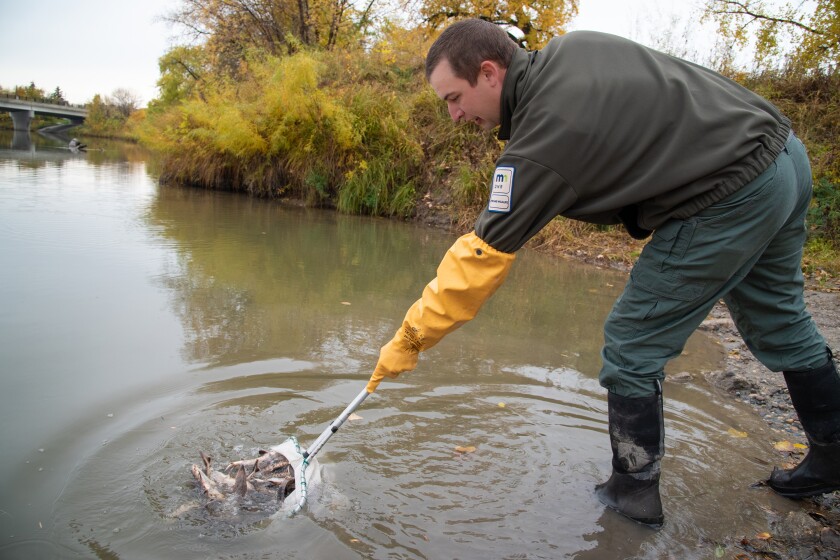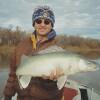CROOKSTON – Ongoing efforts to re-establish lake sturgeon populations in the Red River Basin have entered a new phase, with the recent stocking of lake sturgeon fingerlings into two key rivers within the basin.
According to Nick Kludt, Red River fisheries specialist for the Minnesota Department of Natural Resources in Detroit Lakes, stocking efforts from 2002 up until 2022 largely focused on lakes within the basin. That included Otter Tail Lake, Detroit Lake, Round Lake and Red and White Earth lakes, Kludt said, the latter two in cooperation with the Red Lake and White Earth nations.
ADVERTISEMENT
On Tuesday, Sept. 12, the North Dakota Game and Fish Department That was followed Wednesday, Oct. 18, with the stocking of 1,548 lake sturgeon fingerlings by DNR and U.S. Fish and Wildlife Service personnel into the Red Lake River at Central Park in Crookston.
Both stocking efforts resulted from lake sturgeon eggs collected last spring at Franz Jevne State Park on the Rainy River and raised at the Valley City National Fish Hatchery in North Dakota, Kludt said. Staff from the Minnesota DNR and the U.S. Fish and Wildlife Service collected the eggs, he said, and tribal partners contributed equipment and funding.

The hope, Kludt says, is that lake sturgeon will develop “site fidelity” to the rivers where they are stocked – essentially a homing instinct.
“We suspect – we don’t know – that a lot of the site fidelity that lake sturgeon develop comes at the larval or very early juvenile stage, based on some experimental work on their ability to detect smells,” Kludt said. “However, we know that some learning also occurs with adult fish, based on examples from Red River tributaries where they are now using sites. Of course, it wasn’t possible for them to develop that site fidelity as larvae or very early juveniles because they’re stocked fish.”
On the rebound
Native to the Red River and its tributaries, lake sturgeon were all but gone from the basin by the early 1900s, the result of low-head dams that blocked access to key spawning sites and habitat degradation resulting from settlement of the Red River Valley.
Through a partnership between the Minnesota DNR, U.S. Fish and Wildlife Service, North Dakota Game and Fish Department and the Red Lake and White Earth nations, among others, sturgeon recovery efforts have been underway across the Red River Basin since about 1997.
The efforts are paying dividends, and the basin’s first verified lake sturgeon spawning run in more than 100 years was observed in May 2022 in the upper Otter Tail River, a Red River tributary.
ADVERTISEMENT
Fishable populations now exist in parts of the Red River Basin, and sturgeon in excess of 50 inches have been documented both by anglers and fisheries crews.
The recent stocking of lake sturgeon fingerlings in the Pembina River – the first of its kind in North Dakota – was done in anticipation of a low-head dam in the city of Pembina being modified into a fish passage structure.

“That’s really exciting,” Kludt said. “No. 1, because the program is now expanding into North Dakota, and the North Dakota Game and Fish has been working with the U.S. Fish and Wildlife Service, as well as the city of Pembina, to come up with an alternative plan at the permanent dam for fish passage.
“That’s extremely important because the Pembina River is about 125 miles of extremely good lake sturgeon spawning habitat. So, if they’re able to modify that within the next handful of years, that is going to be another well-timed fish passage project, given the need for access to that spawning habitat.”
All eight of the low-head dams on the mainstem Red River, and dams on numerous tributaries within the basin, also have been modified or replaced with rock fishway structures that accommodate fish passage and improve safety while still holding back water for human use.
“As the last of the mainstem dams, it’s been a long time coming and a longtime target,” Kludt said of the Drayton Dam project. “But given the maturity cycle of those females, the ability for them to transition freely about the basin to complete their migrations, we achieved that milestone right on schedule with when it needed to be achieved.”
until 15 years for males and 25 years for females, according to the DNR.
ADVERTISEMENT
Looking ahead
River stockings will continue until 2029, Kludt said, at which time project partners will assess whether future efforts are necessary or if there’s enough natural reproduction to sustain and grow the lake sturgeon population within the basin.
The Red Lake River will be the focus of stocking efforts in Minnesota, Kludt says, although the Otter Tail, Buffalo and Roseau rivers also are potential sites if production allows.
The future of lake sturgeon populations in the Red River Basin indeed looks bright.
“The remarkable thing is, how positive it is,” Kludt said. “This is a program that is showing excellent signs of success. It’s been a longtime positive collaboration between DNR, Fish and Wildlife Service and the tribal agencies. And it should be noted that over the course of this whole recovery program, we didn’t always see eye to eye on various other natural resource issues, but this one has really been a positive focal point of us all working together toward common goals for over 20 years now.”











